The Nina Hipkins, John Trimmer’s Volvo Open 70,
a pair of Fife Cicely’s an ocean apart, the Fiesta
one design class and a boat called Vera!
WTWB/October 2010


Final time to tell you, be distinctive you model sailboat people, make your mark with a festooned cap or form of headgear. This is a relaxing, fun form of activity with room for individuality and after you’ve slipped anchor and `upped’ and sailed from life, if you can’t be remembered for your humour (er `humor’ for my American friends!) or your friendliness to fellow sailors or your sailing skills, your kindness or your modesty, at least be remembered for the festooned form of colourful headgear you wore when sailing model yachts!


John Trimmer with his Volvo Open 70 boat
John Trimmer of the Poole Model Yacht and Boat Club in Dorset, England
still sails and enjoys his Volvo Open 70 class boat Life at the Extreme which he is seen with in the above photograph by M Millard. Built (or rather `assembled’) by John from a kit, it makes a pretty stunning sailing model which John reviewed in the April 2009 issue of Marine Modelling International, where it was also featured on the cover. Ideal for non-serious racing (or just windling) – and for the former you’d need a fleet of them, they could be the basis for a very `different’ class of ready to race kit boats. (First you need a really switched on, full of drive and enthusiastic promoter who needs to get the importing agents for the kit on his or her side. Ideas never sell themselves do they and enthusiasm is absolutely priceless!)


David Swain with Fiesta Number 28
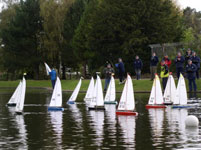
A fleet of Fiestas |

Skippers and their Fiesta yachts |
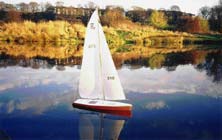
Fiesta owned by Ray Scott |
 |
| A Swain early memory - the Duplex 575 |
I first corresponded with David Swain many years ago when as the concept creator of his Fiesta model yachts, as I recall he had at that point produced nearly one hundred boats in kit form He had always had an interest in smaller sized model yachts, and for some seven or eight years he had run the Harvey Middleton 590 (some may remember those boats) class Nationals with the Oxford Model Boat Club, even before that for the Duplex 575 Ocean Racer boats.
Then David turned to producing his own brainchild, Stewart a fellow club member undertaking the design and the sailmaking of the one design 640mm long boatthey originally toyed with calling the Carnival, later called the Fiesta. Things progressed and as demand developed and clubs ordered the kits, before he knew it they had produced 250 kits before lack of adequate space for storage of even the boxes in a workshop at David’s new smaller home ended his involvement.
Marcia and Tony Watson of M & M Developments in Newport, South Wales took over production of the boats in kit form under an arrangement . These days the boats are available solely from them and there is a seemingly active Fiesta Owners Association with an Internet website of its own.
The Fiesta Owners Association
A one-design boat means that the sailing ability of the Fiesta’s remains identical, with the ability of the skippers the prime factor in racing success. The most successful example of one-design model yachts is the Townson `Electron’ out of New Zealand with 1,600 boats, each one built and delivered ready to sail by one man, a Kiwi, the late Des Townson. Another one -design of merit by Jon Elmaleh is the Nirvana marketed in America and enjoying popularity. I wrote about those boats in the April column.

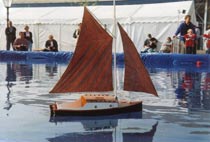
Steve Jackson's Vera |

|
| and another look .... |
Vera, seen above was built by Steve Jackson of the Shepton Mallet Drifters Model Boat Club in the United Kingdom. Built with hull and sails from a Chris Brown’s Holly, the deck and cabin from a boat built around 1900 found in a Glastonbury boatyard. Steve planked the hull from old drawer sides with PVA glue and black paint, the prop driven by a 12 volt motor on 6 volts via micro switches on the sail arm servo. Vera appears to be about 30” in length.
Shepton Mallet is a small town in Somerset in South West England. The club sails at Collett Park lake. The club Chairman is Barrie Stevens, editor of Marine Modelling International. Those serious about model boats should consider regular reading of this publication.


A ship from the era of ARRRGHS
I have to confess that I am a fan of `one-off’ boats, not that I want to own them, rather because they are usually `different’ and their appearance on sailing ponds inject enthusiasm, open `idea buds’ and generally do a lot for keeping the model sailboating hobby `alive’. I enjoy my sailing no question about that but I am a `scribbler’ and storyteller first and foremost as many will have guessed. I am a romanticist also, and a purveyor of tales often based on the long forgotten past.



Tom is a friend of mine from bak in 2004 when we established contact by email that enabled me to do a story on him in the April 2004 issue of my magazine of that time, Windling World. Tom lives with his wife Lori and several kids in Missouri about 20 miles north of Kansas City where he owns the company he started and from which he works called Spotwood Studio.
Tom is a craftsman who makes a living producing models, the majority of which are ordered on commission usually for presentation to others. The fact that he is not a sailor is quite amazing when one looks at the apparent standard of his model display yachts which he painstakingly creates from manufacturers plans, drawings and photos.
The model shown here of the 57í Sarava I encourage you to take a good look at, and admire the absolute wealth of detail that the model has on board. It is interesting to note that the original boat was designed and owned for awhile after being built by Ortona in Viareggio, Italy by Fabio Perrini who later founded Perrini Navi, the Italian shipyard in the province of Tuscany. Of further interest is the discovery that this shipyard were the builders of the 88m long Maltese Falcon.
The model was built by Tom to a commission by Arther Weissman of Florida intended as a gift for his brother. Each of Tomís models of yachts takes a hundred to one hundred and eighty hours to complete, and are often ordered by yacht clubs for presentation to owners and club sailors for some meritorious service. Go on, Google his website, Spotwood Studio, it is an interesting one. Hope the business is going well Tom. Good health.

Worth a thought. When you are out sailing and the model ends up in the lakeside reeds, remember the all important `Law of Location’. No matter where you go, there you are! Things used to be so simple!

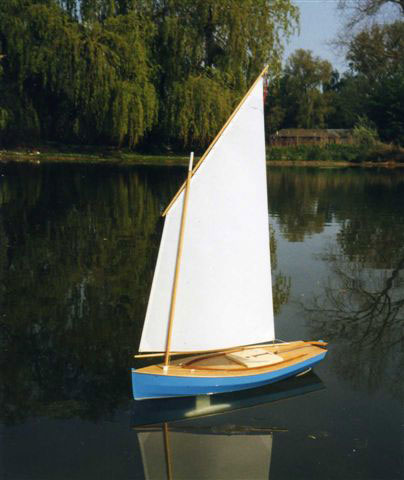
Above is a 30” model of the Nigel Irons designed Western Skiff built and sailed by Richard Bass of Leicester in Great Britain. It is of nice clean hull lines, carries one large lug sail and a fairly short keel which makes it ideal for `weedy’ water conditions. A pretty boat I think.
Impossible you might say…for one man to have the ability to look in two opposite directions at the same time! Not difficult at all for the figure on Auckland Ancient Mariner Murray White’s model Black Joke below left that I call THABTO (`Two heads are better than one’) who is able to keep an eye on the course ahead, and keep an eye on the movements of the fleet behind!
Handy don’t you think?
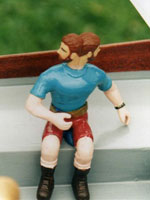
Two heads are better than one! |
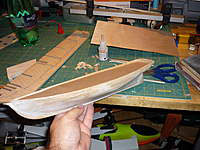
One of Phillip Artweger's
smallest Schooner entries
at hull stage |

Photo above right is one of my friend Phillip Artweger’s creations at hull stage, a 1:85 scale RC, nine to ten inch long scale model of America. It is to be an entry in the writer’s challenge to find the smallest RC model schooner on our planet to culminate with an article in Marine Modelling International, the UK published magazine next year.
You have two weeks left to enter and send photos of your tiny RC and/or freesail model schooner for entries close on November 15th

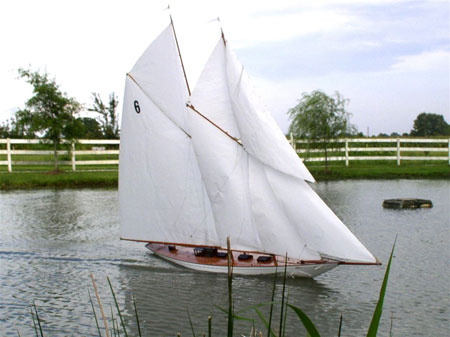
Flat water glide-along
Way back in 1902 Fairlie in Scotland built a schooner for a Mr Cecil Quentin designed by the legendary William Fife. The boat’s name was Cicely, originally built as a fast cruising yacht but it was not long before her owner developed a passion for racing her and she went on to excel in strong winds when close-hauled and won countless races against fast yachts that included both Nordwest and the much acclaimed Clara.
Cicely was 114 feet long with a bow of the modern order of clipper bows, a long and graceful counter and had plenty of freeboard. She was arguably the most beautiful of schooners and it was sad when in 1950 after she had undergone a name change to Lamora she was wrecked on the South Coast of England sailing a cut-down rig when starting a world cruise.
Two friends of mine have chosen to build a beautiful RC sailing model each of this really beautiful schooner, Andrew Charters of Meggett in South Carolina was the first, who launched his six foot long model on June 6th 2004 and photographs of my story in Windling World’s April 2005 issue so inspired reader and sailing colleague, Derek Nicholson of Auckland, New Zealand that he set to work and built one also

A wonderful shot of Andrew's Cicely - taken by Pat Butterworth

Andrew between two of his schooners, Cicely Nearest the camera. You can see how large the Fife is |

Cicely alongside Columbia sail number 8 some years ago, both boats built and owned by Andrew Charters. |
Andrew has sailed and raced his white-hulled Cicely (seen above)over the years that followed in Regatta’s in Maryland, at Mystic Seaport and elsewhere, the model always attracting great attention, Derek’s black-hulled and slightly smaller boat has often been sailed at Onepoto lagoon with our Ancient Mariners windling group. Both are commendable models, well thought out, both well built and each boat sailing an ocean apart excellent,an example of Fife’s schooner design styling characteristics. What a treat it would be to witness the impossible, certainly the unlikely, that of seeing both in close company on a beat together or flying downwind, black and white hulls just a mere meter from each other.
Derek Nicholson’s model of Cicely is also a stunning looker on and off the water. It is somewhat smaller than Andrew’s version and has a black hull but it is also beautifully finished and attracts attention whenever sailed at Onepoto lagoon just over the Auckland Harbour Bridge going north. At 1,620mm length overall (that includes the bowsprit) it is capable of being taken out of the car and transported virtually fully rigged to the water by its owner alone, whereas the Charters model in South Carolina requires a trailer to transport and a two man `lift’(one at the bow, one at the stern) to launch and take out of the water.

Helicopter-eye view |
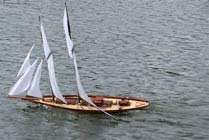
Wind fills the sails |

Derek's black hulled version of CICELY

Irishman Tom who travels a lot wants to know where Ghobadi Bhaba actually is (having read in a back issue of Windling World that it is the place where the World Coconut Husk Model Boat Championships are now to be held in 2013.) Well Tom I can help you on this one: It is a large island said to be both mythical and mystical, it’s location a nine hour largely-ocean paddle by canoe in often shark-frequented and saltwater crocodile waters, heading West from Chungadara in Nguruland. which is entered via the Wog Shoals strait. That clear enough? (Contact Paddle and Piddle Cheep Cheep Tours on `thinternet!’ If you believe that you’ll probably believe anything!)

Ron Rule of Auckland, New Zealand’s Ancient Mariners (I’ve shown his boats in this column regularly!) is a man that `thinks outside the box’ and quite often comes up with boats with un-imaginable `differences’, examples being a clear-plastic hulled Starlet, a schooner (RC et al) its hull made from a dried bit of palm bark – the completed boat christened PALM-IR, and a little catamaran with a mast that shifts from side to side dependent on the wind direction encountered.

Sea Thru the clear platic hulled Starlet |
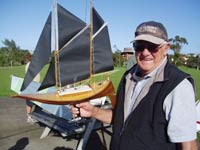
The builder with the Palm-ir |

X Piremental Cat
What’s he done now? Not many would think about a yacht placement of batteries under the water inside the bulb of the keel, now would they? Unfortunately I can’t show you the boat as it is pretty impossible to tell that there is a battery sealed in a bulb and it looks a bit like an ordinary Starlet anyway. It does however add up to a measure of innovative thinking.
As I’ve said to Ron, it is good to `think outside the box’ when one is outside the box themselves, not wait until one is inside the box, when such thoughts would be both depressing and unlikely to lead to anything… and probably nobody would hear you anyway!




The Nina Hipkins
Square-Riggers! I could not build one for I don’t possess the skill or the patience to do so, and another thing, once built and used for sailing on the pond, I think they not only require molly-coddling attention and constant maintenance because of their excessive rigging and the careful handling required and many become `glass encased’ purely display models.
But I love them, love looking at them and watching them sail for they conjure up the true images of that `lost past’ I was speaking about and I’d like to share with you a truly beautiful painting (above) by a late friend of mine, a dear lady who died in her early nineties. Done in oils (probably from a photograph) it shows the ship sailing up a coast in a choppy sea. It hangs in my home office and I don’t know where the scene is meant to represent, or the name of the vessel. A treasured possession and a reminder of a great long friendship. I have decided that it is the Nina Hipkins because that was her name. A nice enough note on which to end this month’s issue.

-30-
| 
